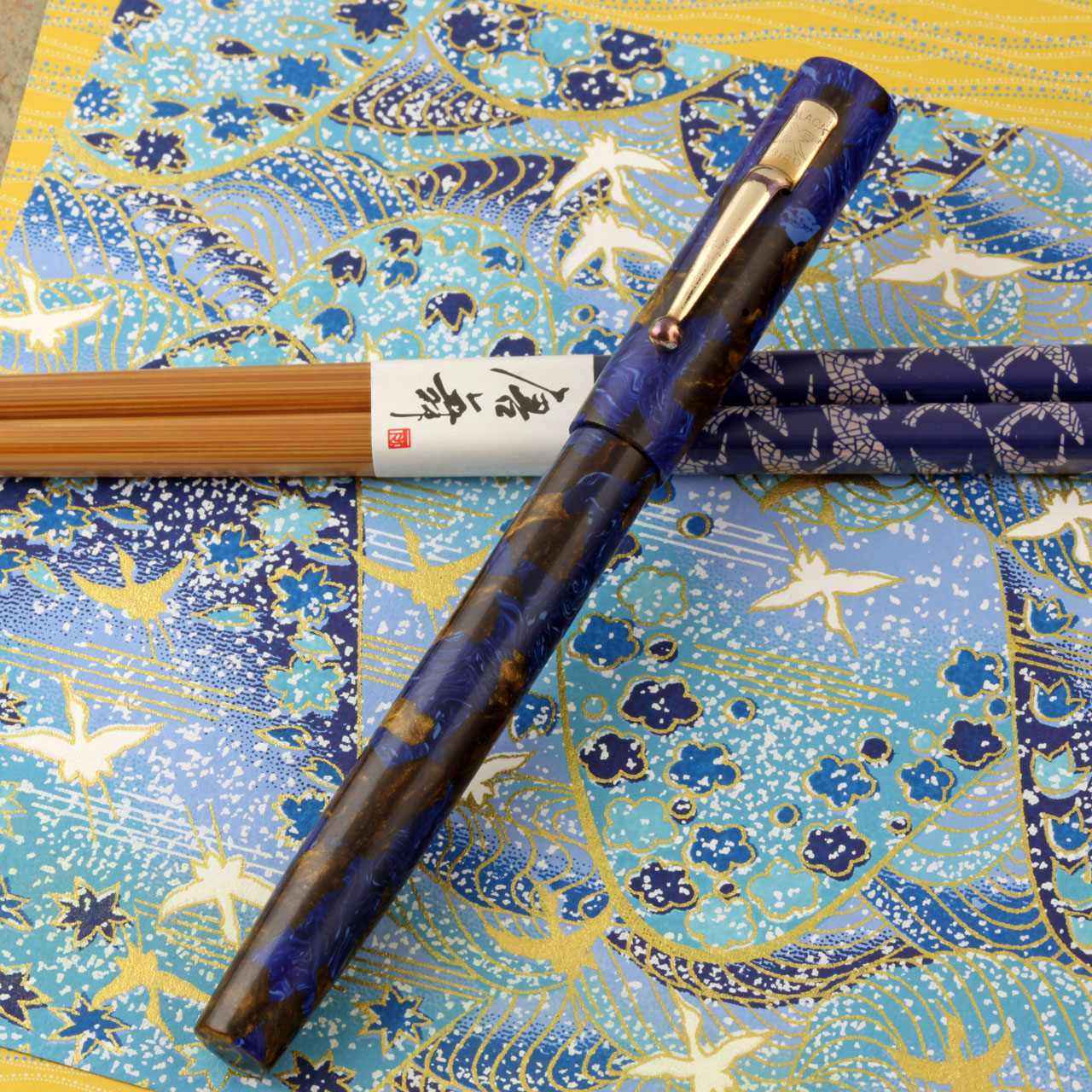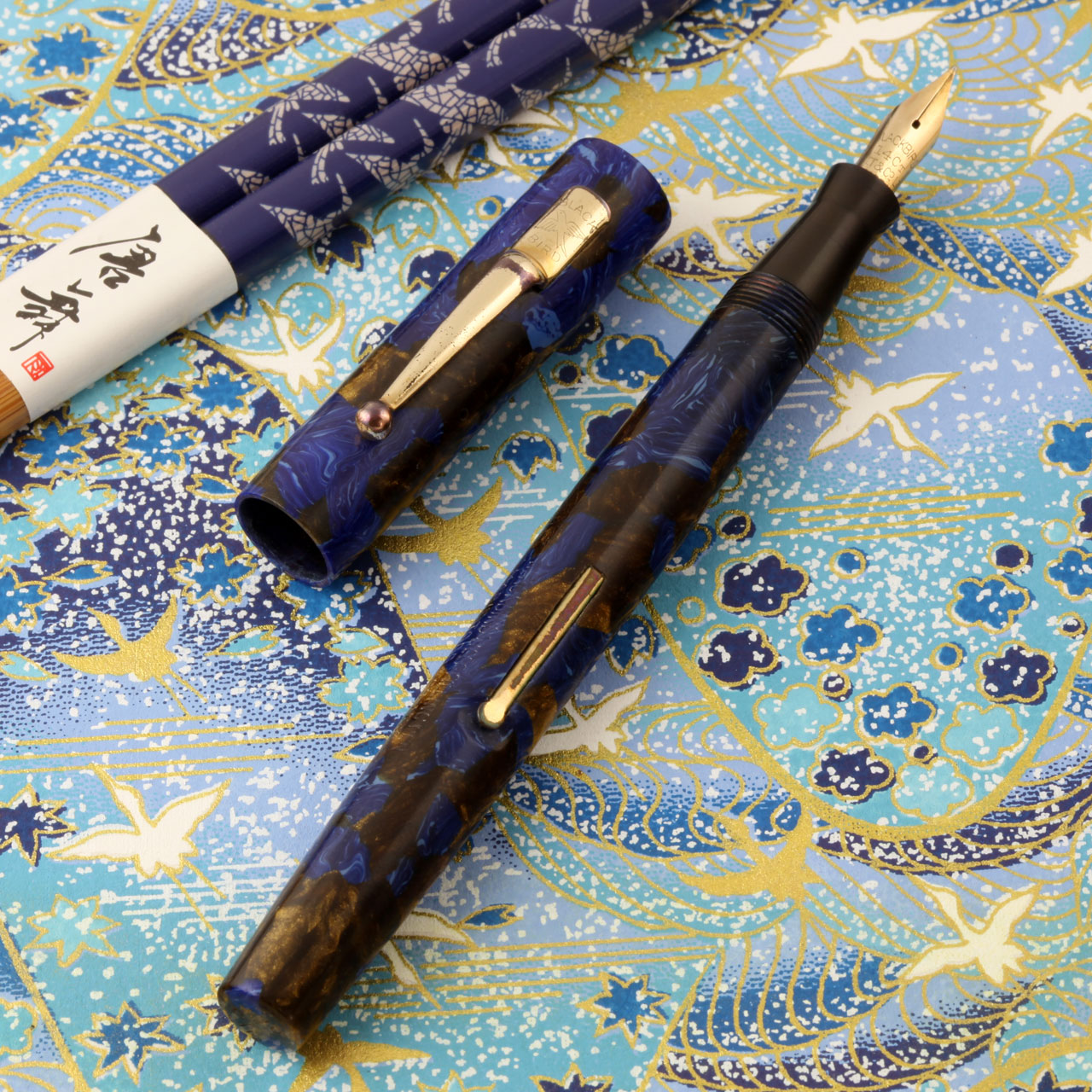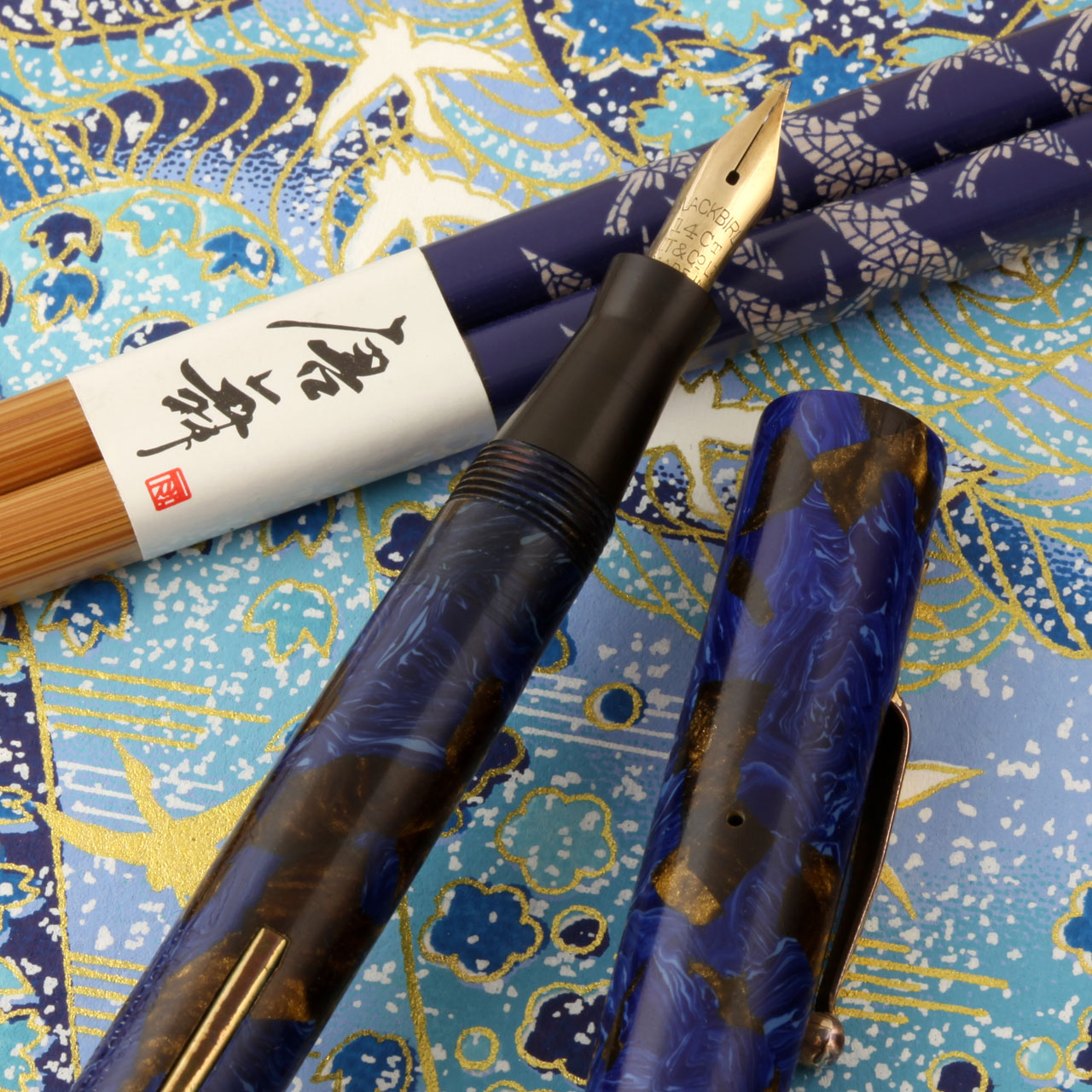Mabie Todd Blackbird Oriental Blue BB2/46 c1933
by Jim Mamoulides, October 31, 2003, updated July 7, 2018
 Mabie Todd Blackbird Oriental Blue BB2/46 c1933
Mabie Todd Blackbird Oriental Blue BB2/46 c1933
More shades of the Orient
Every once in a while a pen comes along that strikes a strong chord of, "I have to have one of those!" I felt this way after seeing my first Mabie Todd Blackbird in Oriental Blue. Colors of the Orient were the rage in the 1920s and 1930s and pen companies, armed with new vivid colored plastics, were set on capturing as much of this interest as they possibly could. Parker played this up with its "Chinese Lacquer Red" and "Mandarin Yellow" Duofolds. Green marbled pens were called "Jade" by almost every manufacturer.
Haven't we met somewhere before?
In the mid 1920s, the early years of plastic pens, manufacturers tried to protect not only their designs, but also the specific plastic used. Parker Duofold pens became strongly associated with a burnt orange "red" and Sheaffer wowed the market with its "jade" green flat-top.
 Mabie Todd Blackbird Oriental Blue BB2/46 c1933
Mabie Todd Blackbird Oriental Blue BB2/46 c1933
By the 1930s, as more and more plastic designs became available, they began to show up on more brands, with the expected result of the same pattern plastic showing up on different maker's pens. Conklin used the same burgundy and black plastic in the Symetrik as Parker used in the Streamline Duofold, for example. The herringbone and marble pattern seen on the Parker Royal Challenger can also be seen on Diamond Point pens from the same period.
This "Oriental Blue" celluloid is not exclusive to the Mabie Todd Blackbird. Waterman used it on the Patrician c1929-1936, calling the color "Turquoise". It's used on a Parker "thrift" model. Summit also used it on a pen quite similar to the Blackbird. It can also be found on pens branded Ford's and Stephens.
A vividly colorful Blackbird
This particular Blackbird style was part of the English made lines, and was first available as a flat-top design, probably as early as 1927, through the end of the flat-tops by 1934. The Blackbird line was a second line for Mabie Todd, and was priced accordingly. Where the lowest cost Swan in the mid-1930s might sell for 17/6, Blackbirds were a very modest 7/6. Visually a Blackbird pen would be plain, lacking the many cap and barrel bands found on the Swan line. The Swan line was the top Mabie, Todd and Company line and the brand eclipsed the company name.
 Mabie Todd Blackbird Oriental Blue BB2/46 c1933
Mabie Todd Blackbird Oriental Blue BB2/46 c1933
Oriental Blue Blackbirds do not appear in the 1927 to 1932 Mabie Todd catalogs, though the slim design model BB2 with no cap band and stepped clip Blackbird does. It's possible that this pen, model BB2 with color 46, Oriental Blue, first appeared in 1933.
When Mabie Todd revamped their lines in 1934 to a more tapered and compact design, the Blackbird followed suit. The Oriental Blue plastic continued with the new redesigned model, which has a quite different clip, probably from 1934 through at least the end of the 1930s.
Unlike the top Swan lines, the Oriental Blue Blackbird was only offered as a bandless side-lever "Self-Filler" pen. There are clipless pens as well. The early flat-top style model is 5 1/4 inches capped and 6 1/2 inches posted. The later model is slightly shorter, at 5 inches capped.
Performance
The early plastic Blackbird line closely follows the design of the higher line Swan pens but with less ornamentation and a smaller diameter. Though less well appointed, the vivid blue and gold plastic more than makes up for the lack of ornamentation. The blue swirls have the same visual flow as a Van Gogh painting. You can almost see the "Starry Night" in the blue around the golden brown slivers.
 Mabie Todd Blackbird Oriental Blue BB2/46 c1933 nib detail
Mabie Todd Blackbird Oriental Blue BB2/46 c1933 nib detail
Side by side with a Mabie Todd Swan Eternal, two things point to this being a lower price pen. The first is the lack of bright appointments. By itself, the Blackbird is a very pretty pen. It really is too bad that Mabie Todd did not see fit to use this plastic on its Eternals, as Waterman did with the Patrician. It would be a gorgeous pen with more bright work. The second is the nib. Eternals have large and exceptionally smooth nibs. The nib in this pen is small in proportion to the barrel. Though unmarked, it's probably a number 2. A larger nib would be an upgrade.
Though a flat-top design, the pen has a gentle taper in the barrel, making it very easy to post, and the cap and barrel ends have a soft edge to them. The tabbed style of the front mounted clip signals that this is a Mabie Todd pen, a clip design used by several other English pen manufacturers.
The pen rides high in the pocket because of the front mounted placement of the clip, and because the tab moves the clipping section lower. A bright spot in a blue and bronze background peeks out of the pocket. The clip holds securely, keeping the pen snug and in place. This is a long and slender pen, as long as a Parker Duofold Oversize, but without the girth. It's very well made, as with other Mabie Todd pens, and polishes up to a very nice and deep luster. It's about 5 1/4 inches capped and a long 6 1/2 inches posted. It posts well, but can be written with either way, as the barrel is quite long, and is well balanced either way.
 Mabie Todd Blackbird Oriental Blue BB2/46 c1933 clip and imprint detail
Mabie Todd Blackbird Oriental Blue BB2/46 c1933 clip and imprint detail
The pen fills easily with a pull of the lever and writes quite wet with its very soft and flexible medium nib. A very expressive writer. It took some smoothing work, as the tipping was initially a bit rough. After some work it turned into a really nice writer.
Blackbirds are generally plain pens that sometimes come in fun wrappers, like this one. It's very well made and is a very nice daily user. Among Blackbirds, Oriental Blue pens will command a very high premium, placing them in the price range of some of the large Eternal models. A mint or near mint pen will fetch a very nice price. Take care to examine any Mabie Todd pen for plating problems, as Mabie Todds appear to be prone to plating loss, as this example clearly shows.
If you like pretty pens like Parker True Blues and Sheaffer 3-25 blue black marble pens, you should consider an Oriental Blue pen, too. It will cost you a lot less than that Turquoise Waterman Patrician!
Acknowledgment
Thanks to Martin Eymer for providing examples of the Oriental Blue celluloid on Parker, Ford's and Stephens pens.
References
Fountain Pens of the World by Andreas Lambrou, © 1995 Zwemmer, London, United Kingdom
Mabie, Todd & Company LTD Catalog 1927
Mabie, Todd & Company LTD Catalog 1930
Mabie, Todd & Company LTD Catalog 1932
Interact
Comments on this article may be sent to the editor, Jim Mamoulides


